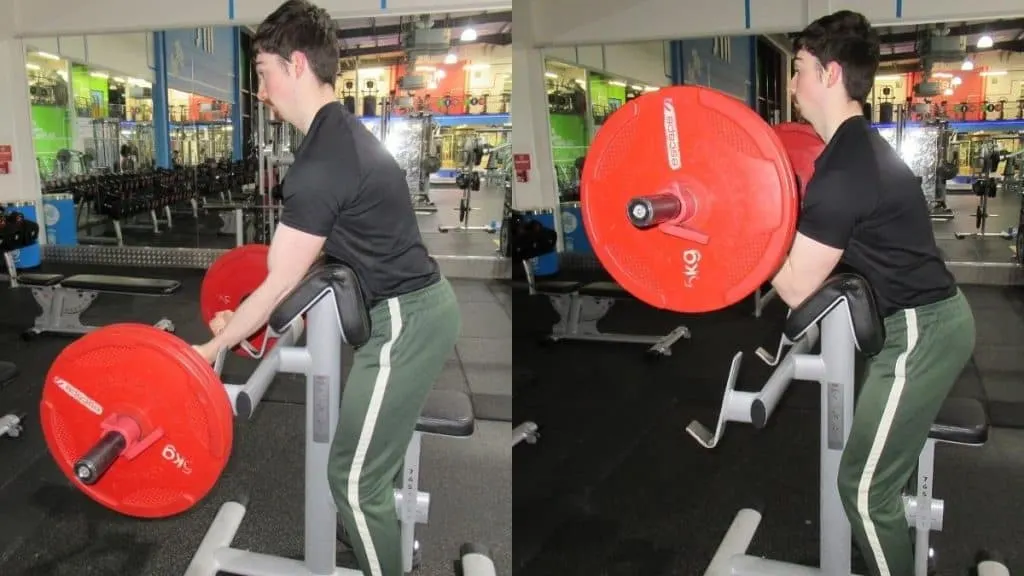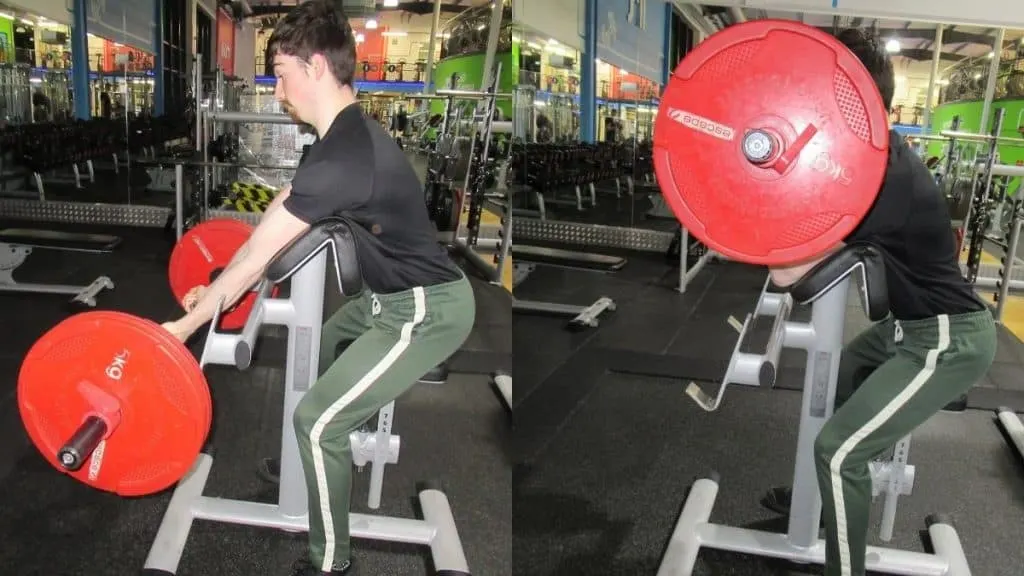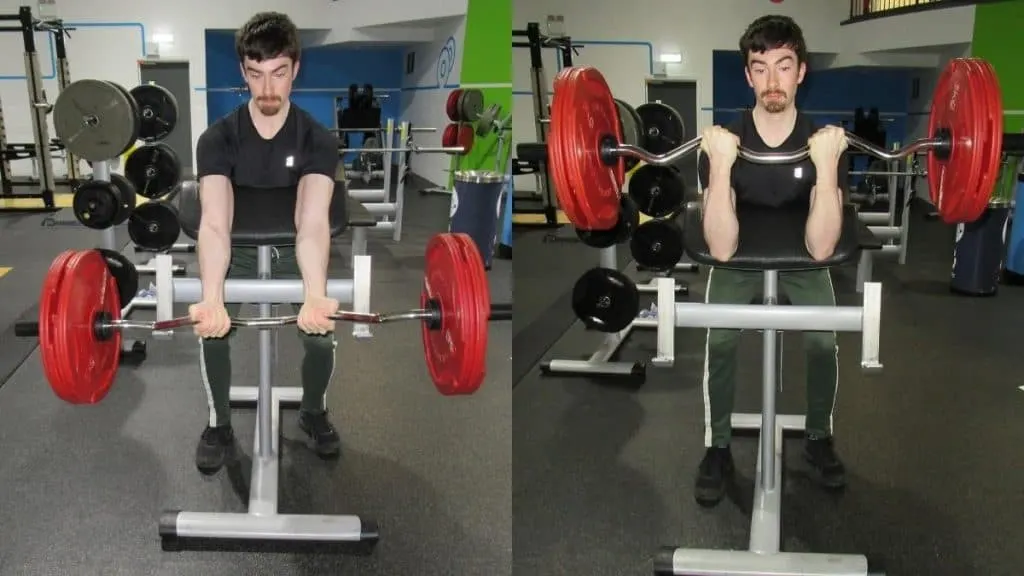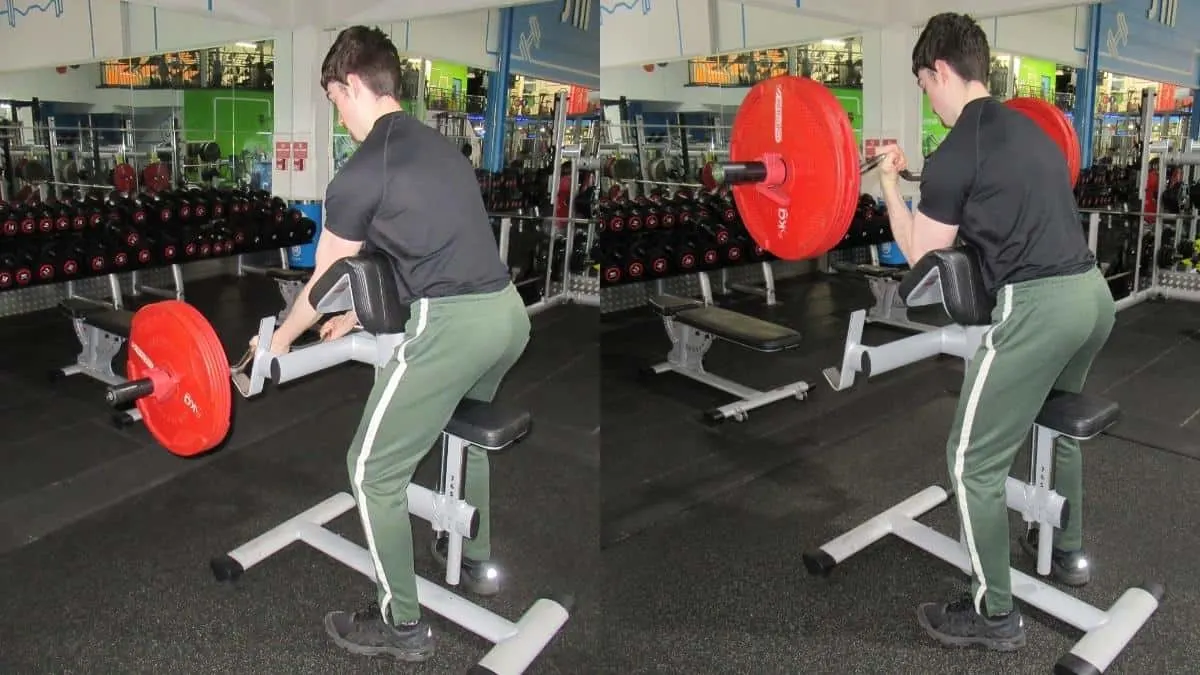Standing preacher curls work the bicep, brachialis, and forearm muscles through a combination of elbow flexion and wrist supination. Although they’re easier to set up than the regular preacher curl, standing barbell preacher curls require more core stability and are thus slightly less effective at isolating the biceps.
This tutorial shows you how to perform standing preacher curls correctly and then weighs up the pros and cons of the exercise so that you can decide if it’s right for your goals.
Standing preacher curl exercise details
- Main Muscles: Biceps brachii
- Secondary Muscles: Brachialis, brachioradialis, forearm flexors
- Exercise Type: Strength
- Exercise Mechanics: Isolation
- Difficulty Level: Intermediate
- Equipment Needed: Barbell, weights, preacher curl station.
How to do standing preacher curls
- Load some weights onto a bar and then rest it in the preacher rack.
- Stand behind the preacher curl station and brace your arms against the sloped side of the pad.
- Grab the bar with an underhand, shoulder-width grip.
- Curl the weights toward your shoulders.
- Keep lifting until your forearm and bicep muscles make forceful contact.
- Squeeze your biceps as hard as you can, and then lower the bar under control until your arms are fully locked out.
- Repeat for 3-5 sets of 8-12 reps.
Standing preacher curl pros and cons
The standing bicep preacher curl is a fantastic exercise for building your biceps because the preacher pad makes it very hard to cheat the weight up, which ensures that the target muscles receive the majority of the tension. However, there are also a few downsides to the exercise that you need to consider before making it a staple in your workout routine.
Pro: Easier setup

With the regular narrow grip preacher curl and the standard wide grip preacher curl—both of which are typically performed sitting down—it can be difficult to reach the barbell without lifting your hips off the seat. This means that you have to reposition your arms with the bar in your hands, which can be surprisingly challenging when you’re lifting heavy weights.
Likewise, at the end of your set, you often have to momentarily stand up in order to place the bar back on the rack, which can be uncomfortable when your arms are already fatigued.
Of course, you could just drop the bar into the rack. But then you’ll draw attention to yourself and possibly get in trouble with the gym staff.
But if you do the preacher curl standing up, then grabbing and releasing the bar is never an issue. So as a result, you can put more focus and effort into working your biceps because you don’t need to figure out how to get the bar into your hands and then drop it after a tough set.
With the standing version, you also don’t need to worry about adjusting the seat height. Rather than fitting your body to a predetermined seat position, you get to fit the preacher station to your body by either bending your knees or straightening out your legs more, depending on your height.
Con: Requires more core stability

Although standing preacher curls are straightforward to set up, you need to have a strong core to keep your torso in the correct position. This can make it harder to focus on your biceps because you constantly have to think about flexing your abs in order to maintain the proper form.
The solution is to perform standing BB preacher curls later on in your workout when your biceps are already fatigued. [1] This way, you’ll naturally be lifting lighter weights and therefore won’t need to exert the same effort in order to maintain a tight core.
Of course, someone who’s strong enough to lift heavy on preacher curls probably has the core strength to match. Still, if muscle growth rather than pure strength is your primary focus, then you might want to consider sticking with the seated version so that you can better isolate your arms.
Pro: Higher calorie burn

Standing exercises burn more calories than seated exercises because the former type works more muscles and requires greater stability. [2] Of course, with isolation exercises like standing preacher curls, the difference isn’t massive and is likely not even worth your consideration.
But if you’re cutting and want to do everything in your power to maximize your calorie expenditure in the gym, then it’s a good idea to choose exercises that involve more muscles—even if its just for stabilization purposes (like the abs in the case of the standing preacher curl).
Related Exercise: Preacher reverse curl
The verdict: Should you do the preacher curl standing up or sitting down?

While it’s true that you should do your curls sitting down for maximum bicep isolation, standing preacher curls are still a highly convenient exercise that offers many advantages. With the standing version, you don’t have to worry about finding and then remembering the correct seat position, which saves you time in the gym and prevents needless stress.
Similarly, it’s easier to pick up and release the bar when you do the preacher curl standing up because your arms are further down the pad. This means that you can enjoy a more efficient workout because you don’t need to spend as much time on the setup.
The downside, of course, is that the standing preacher curl requires a strong core because the bar is always trying to pull your torso forward. This will make it harder to focus on your biceps, which isn’t a problem in and of itself, but it’s not optimal if you’re a bodybuilder seeking maximum muscle isolation.
References
- Ament, W., & Verkerke, G. J. (2009). Exercise and Fatigue. Sports Medicine, 39, 389–422. https://link.springer.com/article/10.2165/00007256-200939050-00005
- Rettner, R. (2017, November 14). Trying to Stand More at Work? Here’s How Many More Calories You’ll Burn. Livescience.Com. https://www.livescience.com/60940-sitting-standing-calories.html

